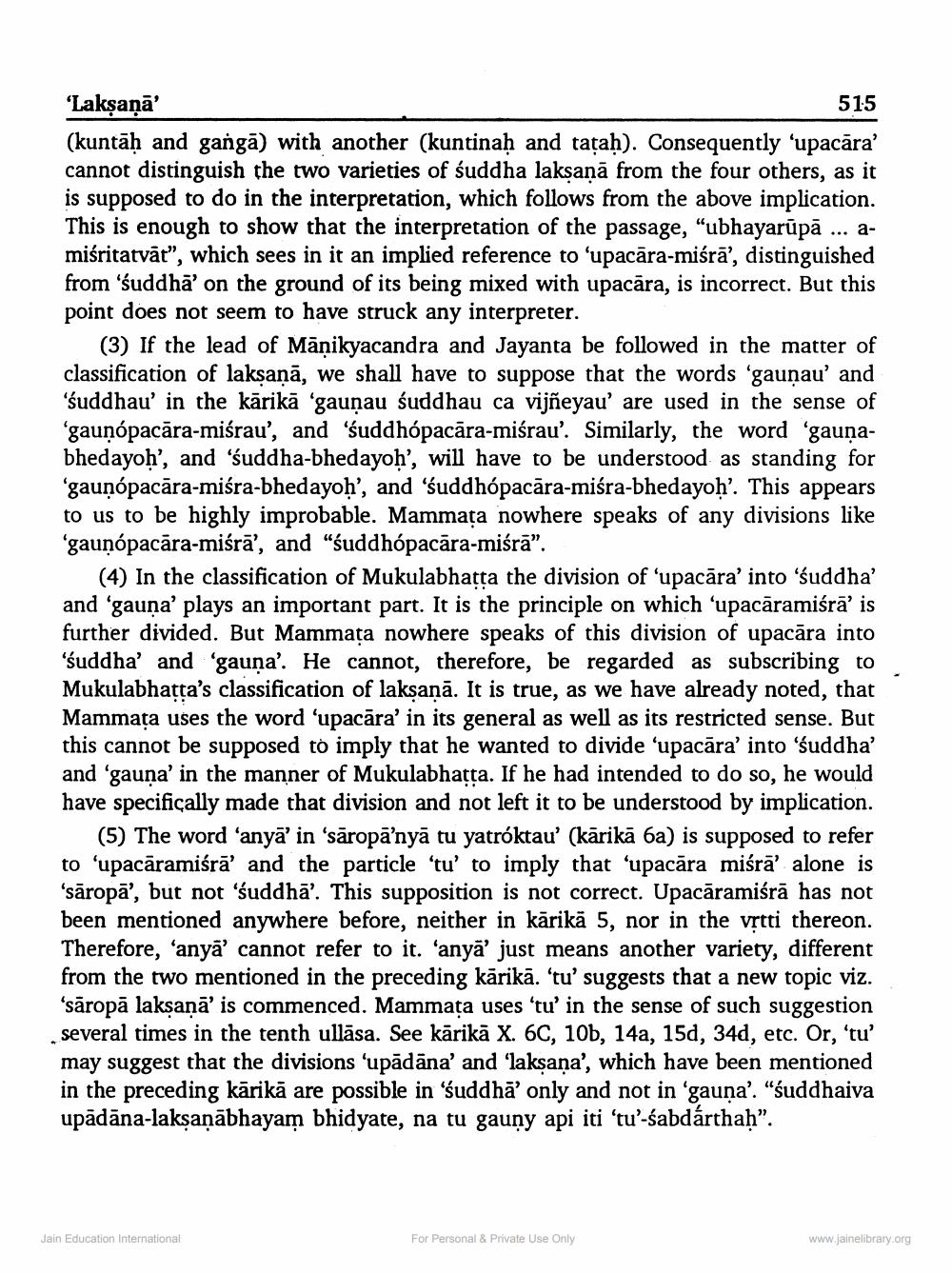________________
'Laksana'
515 (kuntāh and gangā) with another (kuntinah and tatah). Consequently 'upacara cannot distinguish the two varieties of suddha laksanā from the four others, as it is supposed to do in the interpretation, which follows from the above implication. This is enough to show that the interpretation of the passage, "ubhayarūpā ... amiśritatvāt", which sees in it an implied reference to 'upacara-miśrā', distinguished from 'śuddhā' on the ground of its being mixed with upacāra, is incorrect. But this point does not seem to have struck any interpreter.
(3) If the lead of Māņikyacandra and Jayanta be followed in the matter of classification of laksanā, we shall have to suppose that the words 'gaunau' and 'suddhau' in the kārikā 'gaunau śuddhau ca vijñeyau' are used in 'gaunopacāra-miśrau', and 'śuddhópacāra-miśrau'. Similarly, the word 'gaunabhedayoh', and 'śuddha-bhedayoh', will have to be understood as standing for 'gaunopacāra-miśra-bhedayoh', and 'suddhópacāra-miśra-bhedayoh'. This appears to us to be highly improbable. Mammata nowhere speaks of any divisions like 'gaunópacara-miśrā', and "suddhópacara-miśrā".
(4) In the classification of Mukulabhatựa the division of 'upacāra' into 'śuddha' and 'gauna' plays an important part. It is the principle on which 'upacāramiśrā' is further divided. But Mammața nowhere speaks of this division of upacāra into 'śuddha' and 'gauna'. He cannot, therefore, be regarded as subscribing to Mukulabhatta's classification of laksanā. It is true, as we have already noted, that Mammața uses the word 'upacara' in its general as well as its restricted sense. But this cannot be supposed to imply that he wanted to divide ‘upacāra' into 'śuddha' and 'gauna' in the manner of Mukulabhatta. If he had intended to do so, he would have specifically made that division and not left it to be understood by implication.
(5) The word 'anyā’ in 'sāropā’nyā tu yatróktau' (kārikā 6a) is supposed to refer to 'upacāramiśrā' and the particle 'tu' to imply that 'upacara miśrā' alone is 'sāropā', but not 'śuddhā'. This supposition is not correct. Upacarar been mentioned anywhere before, neither in kārikā 5, nor in the vștti thereon. Therefore, 'anyā' cannot refer to it. 'anyā' just means another variety, different from the two mentioned in the preceding kārikā. 'tu' suggests that a new topic viz. 'sāropā laksaņā' is commenced. Mammața uses 'tu' in the sense of such suggestion several times in the tenth ullāsa. See kārikā X. 6C, 106, 14a, 15d, 34d, etc. Or, 'tu' may suggest that the divisions 'upādāna' and 'laksana', which have been mentioned in the preceding kārikā are possible in 'śuddha' only and not in 'gauņa”. “suddhaiva upādāna-laksanābhayam bhidyate, na tu gauny api iti 'tu'-sabdárthah".
Jain Education International
For Personal & Private Use Only
www.jainelibrary.org




